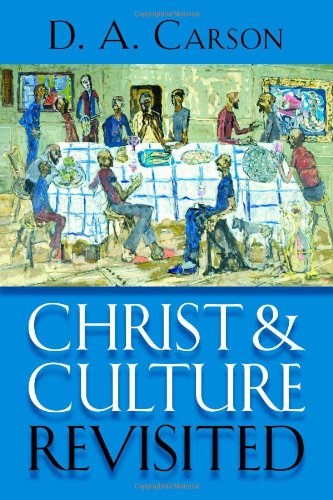A Brief Book Summary from Books At a Glance
About the Author
D. A. Carson is research professor of New Testament at Trinity Evangelical Divinity School, Deerfield, Illinois. He has written or edited more than fifty other books, including The Gagging of God: Christianity Confronts Pluralism, Becoming Conversant with the Emerging Church, and The Intolerance of Tolerance.
Introduction
In this book Carson tackles the controversial subject of the relationship between Christ and culture. He begins by examining and assessing the extraordinarily influential work of Richard Niebuhr. Carson probes Niebuhr’s fivefold typology (Christ against culture, the Christ of culture, Christ above culture, Christ and culture in paradox, and Christ the transformer of culture), and analyzes it on the basis of its consistency with biblical theology. Carson concludes that Niebuhr’s models do not accurately reflect the unity of the Scriptures and the theological priorities of the canon. Turning to the contemporary scene, Carson considers cultural trends (mainly in the West) and suggests ways that Christians can thoughtfully engage in their society, while remaining faithful to the fact that Jesus is Lord over every area of life. This book covers a wide range of issues, but they are engaged with insight and helpful analysis.
Table of Contents
Preface
Chapter 1 How to Think about Culture: Reminding Ourselves about Niebuhr
Chapter 2 Niebuhr Revised: The Impact of Biblical Theology
Chapter 3 Refining Culture and Redefining Postmodernism
Chapter 4 Secularism, Democracy, Freedom, and Power
Chapter 5 Church and State
Chapter 6 On Disputed Agendas, Frustrated Utopias, and Ongoing Tensions
Chapter 1
How to Think about Culture: Reminding Ourselves about Niebuhr
The word culture is understood and defined in a variety of ways. At a basic level, a culture exists where a particular group of people share common values, symbols, and artifacts that shape their communication and interpretation of life. The new covenant community transcends political, geographic, ethnic, and linguistic boundaries, and as such Christians have always wrestled with the relationship between the church and society. Today, multiculturalism and the fact that the Western World is both moving farther from, and growing more hostile toward, Christianity means that the contemporary church needs to wrestle seriously with the relationship between Christ and Culture.
In Western Christianity, the discussion about Christ and Culture is heavily influenced by the seminal work of H. Richard Niebuhr. What Niebuhr means by “Christ” is theologically very broad — he allows a variety of interpretations of Jesus, some of which are sub-biblical. His understanding of culture is likewise broad, but his discussion narrows so that it is really about the relationship between Christ and other sources of authority in culture. Niebuhr explores the relationship between Christ and culture through five models.
1. Christ against Culture. This view of the relationship between Christ and culture is negative. Christ stands in opposition to culture. Christians are called to follow Christ and reject the world. In extreme cases, this requires withdrawing from society as much as possible. This position is necessary but insufficient, and does not work adequately through the ways that the church itself is cultural and the ways that Jesus is the Lord of human history and the world’s savior.
2. The Christ of Culture. In this model, Christ affirms and advances what is best in culture. Cultural Christians recognize that Jesus plays a prophetic role, but Jesus also desires the peace, unity, and moral advance of society. Christians who adhere to this model tend to minimize sin and doctrine, and adhere to the social gospel and inclusivity.
3. Christ above Culture. Niebuhr identifies Christ above culture as the dominant model in church history. It is founded on the understanding that God is the creator of the world, and even though the world is fallen and cursed, culture is still built on the good creation of God. Models #3-5 represent various ways of working out this theme. The current model aims at synthesis: it recognizes that culture is not completely bad, but neither is it completely good. The church should synthesize natural law, societal institutions, creation elements, and theology into a cohesive whole.
4. Christ and Culture in Paradox. Christ is above culture, as he is above every human being. In the first model, Christians look at Christ being against the culture of the world (and thus not against them), but in this model the emphasis is on the fact that God is transcendent and righteous in a way that places him infinitely above everyone, whether they are a believer or not. Both the world and the church fall short of God’s glory. All human works are tainted, yet in the grace of God there is acceptance.
5. Christ the Transformer of Culture. Christ is above culture, but he is a redeemer and transformer. Individuals can be converted and transformed, and as a result whole cultures can be converted, too. When people are regenerated all of their works can be transformed. Thus the gospel can lead to the transformation of culture.
Chapter 2
Niebuhr Revised: The Impact of Biblical Theology
Niebuhr is too broad in the sources that he accepts as representative of Christianity. He accepts as Christian the syncretistic gnostic teachings that were found in early church history. He also accepts classical liberal theology, but it diverges so far from historic Christian orthodoxy that it constitutes another religion rather than a stream of Christianity. Where the incarnation, atonement, and resurrection are denied….
[To continue reading this summary, please see below....]The remainder of this article is premium content. Become a member to continue reading.
Already have an account? Sign In
